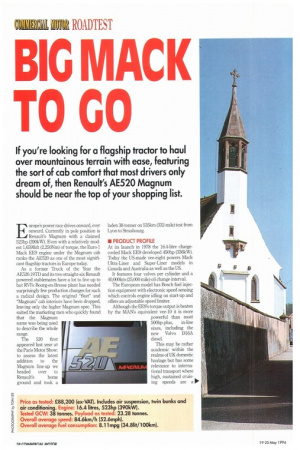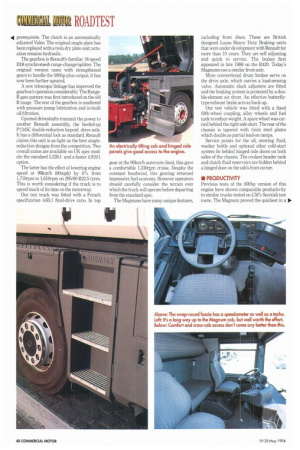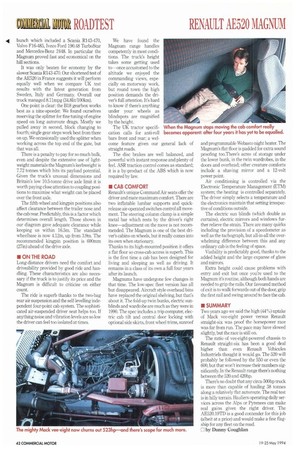BIG MACK TO GO
Page 40

Page 42

Page 44

If you've noticed an error in this article please click here to report it so we can fix it.
If you're looking for a flagship tractor to haul over mountainous terrain with ease, featuring the sort of cab comfort that most drivers only dream of, then Renault's AE520 Magnum should be near the top of your shopping list.
Europe's power race drives onward, ever onward. Currently in pole position is Renault's Magnum with a claimed 523hp (390kW). Even with a relatively modest 1,6591bft (2,250Nm) of torque, the Euro-1 Mack EE9 engine under the Magnum cab ranks the AE520 as one of the most significant flagship tractors in Europe today.
As a former Truck of the Year the AE520.19TD and its two straight-six Renault powered stablemates have a lot to live up to but RVI's Bourg-en-Bresse plant has needed surprisingly few production changes for such a radical design. The original "fleet" and "Magnum" cab interiors have been dropped, leaving only the higher Magnum spec. This suited the marketing men who quickly found that the Magnum name was being used to describe the whole range.
The 520 first appeared last year at the Paris Motor Show: to assess the latest addition to the Magnum line-up we headed over to Renault's home ground and took a laden 38-tonner on 535km (332-mile) test from Lyon to Strasbourg.
• PRODUCT PROFILE
At its launch in 1978 the 16.4-litre chargecooled Mack EE9 developed 450hp (336kVV). Today the US-made vee-eight powers Mack Ultra-Liner and Super-Liner models in Canada and Australia as well as the US.
It features four valves per cylinder and a 40,000km (25,000 mile) oil change interval.
The European model has Bosch fuel injection equipment with electronic speed sensing which controls engine idling on start-up and offers an adjustable speed limiter.
Although the EE9's torque output is beaten by the MAN's equivalent vee-10 it is more powerful than most 500hp-plus, in-line sixes, including the new Volvo D16A diesel.
This may be rather academic within the realms of UK domestic haulage but has some relevance to international transport where high, sustained cruising speeds are a Po' 4 prerequisite. The clutch is an automatically adjusted Valeo. The original single plate has been replaced with a twin dry plate unit actuation remains hydraulic.
The gearbox is Renault's familiar 18-speed B18 synchromesh range-change/splitter. The original version came with strengthened gears to handle the 500hp-plus output; it has now been further upratecl A new telescopic linkage has improved the gearbox's operation considerably. The RangeR gate pattern was first introduced on the old R range. The rest of the gearbox is unaltered with pressure pump lubrication and in-built oil filtration.
Uprated driveshafts transmit the power to another Renault assembly, the beefed-up P1345C double-reduction hypoid drive axle. It has a differential lock as standard. Renault claims this unit is as light as the best singlereduction designs from the competition. Two overall ratios are available on UK spec models: the standard 5.226:1 and a faster 4.919:1 option.
The latter has the effect of lowering engine speed at 961un/h (60mph) by 6% from 1,710rpm to 1,610rpm on 295/80 R22.5 tyres. This is worth considering if the truck is to spend much of its time on the motorway.
Our test truck was fitted with a French specification 4.65:1 final-drive ratio. In top gear at the 90km/h autoroute limit, this gave a comfortable 1,330rpm cruise. Despite the constant headwind, this gearing returned impressive fuel economy. However operators should carefully consider the terrain over which the truck will operate before departing from the standard spec.
The Magnums have many unique features, including front discs. These are British designed Lucas Heavy Duty Braking units that were under development with Renault for more than 10 years. They are self adjusting and quick to service. The brakes first appeared in late 1988 on the R420. Today's Magnums use a similar front axle.
More conventional drum brakes serve on the drive axle, which carries a load-sensing valve. Automatic slack adjusters are fitted and the braking system is protected by a double-element air dryer. An effective butterflytype exhaust brake acts as back up.
Our test vehicle was fitted with a fixed fifth-wheel coupling, alloy wheels and fuel tank to reduce weight. A spare wheel was carried behind the right side skirt. The rear of the chassis is tapered with thick steel plates which double as partial lead-on ramps.
Service points for the oil, steering fluid, washer bottle and optional ether cold-start system lie behind hinged side doors on both sides of the chassis. The coolant header tank and clutch fluid reservoirs are hidden behind a hinged door on the cab's front corner.
• PRODUCTIVITY
Previous tests of the 500hp version of this engine have shown comparable productivity to similar trucks tested on CM'S Scottish test route. The Magnum proved the quickest in a 110.
bunch which included a Scania R143-470, Volvo F16-485, Iveco Ford 190.48 TurboStar and Mercedes-Benz 2448. In particular the Magnum proved fast and economical on the hill sections.
It was only beaten for economy by the slower Scania R143-470. Our shortened test of the AE520 in France suggests it will perform equally well when we compare UK test results with the latest generation from Sweden, Italy and Germany. Overall our truck managed 8.11mpg (34.81ft/100km).
One point is clear: the B18 gearbox works best as a nine-speeder. We found ourselves reserving the splitter for fine tuning of engine speed on long autoroute drags. Mostly we pulled away in second, block changing to fourth; single gear steps work best from there on up. We occasionally used the splitter when working across the top end of the gate, but that was all.
There is a penalty to pay for so much bulk, even and despite the extensive use of lightweight materials the Magnum's kerbweight is 7.72 tonnes which hits its payload potential. Given the truck's unusual dimensions and Britain's low 10.5-tonne drive axle limit it is worth paying close attention to coupling positions to maximise what weight can be placed over the front axle.
The fifth-wheel and kingpin positions also affect clearance between the trailer nose and the cab rear. Predictably, this is a factor which determines overall length. Those shown in our diagram gave adequate clearance while keeping us within 16.5m. The standard wheelbase is now 4.12m, up from 39m. The recommended kingpin position is 690mm (27in) ahead of the drive axle.
• ON THE ROAD Long-distance drivers need the comfort and driveability provided by good ride and handling. These characteristics are also necessary if the truck is to justify its price and the Magnum is difficult to criticise on either count The ride is superb thanks to the two-bag rear air suspension and the self-levelling independent four-point cab system. The sophisticated air-suspended driver seat helps too. If anything noise and vibration levels are so low the driver can feel too isolated at times. We have found the Magnum range handles competently in most conditions. The truck's height takes some getting used to—once accustomed to the altitude we enjoyed the commanding views, especially on motorway work, but round town the high position demands the driver's full attention. It's hard to know if there's anything under your wheels as blindspots are magnified by the height.
The UK tractor specification calls for anti-roll bars front and rear; a welcome feature given our general lack of straight roads.
The disc brakes are well balanced, and powerful with instant response and plenty of feel. ASR traction control comes as standard; it is a by-product of the ABS which is now required by law.
• CAB COMFORT Renault's unique Command Air seats offer the driver and mate maximum comfort. There are two inflatable lumbar supports and quickrelease air-operated switches control all movement. The steering column clamp is a simple metal bar which rests by the driver's right knee—adjustment on the move is not recommended. The Magnum is one of the best driver's cabins on wheels, but it really comes into its own when stationary.
Thanks to its high-mounted position it offers a flat floor so cross-cab access is superb. This is the first time a cab has been designed for living and sleeping as well as driving. It remains in a class of its own a full four years after its launch.
Magnums have undergone few changes in that time. The low-spec fleet version has all but disappeared. Aircraft style overhead bins have replaced the original shelving, but that's about it. The fold-up twin bunks, electric sunblinds and wardrobe are much as they were in 1990. The spec includes a trip computer, electric cab tilt and central door locking with optional side skirts, front wheel trims, sunroof and programmable Webasto night heater. The Magnum's flat floor is padded for extra sound proofing too.There's acres of storage under the lower bunk, in the twin wardrobes, in the doors and overhead; other creature comforts include a shaving mirror and a 12-volt power point.
Air conditioning is controlled via the Electronic Temperature Management (ETM) system; the heating is controlled separately. The driver simply selects a temperature and the electronics maintain that setting irrespective of conditions outside.
The electric sun blinds (which double as curtains), electric mirrors and windows further relieve the strain. There are many quirks including the provision of a speedometer as well as the tachograph, but all-in-all the overwhelming difference between this and any ordinary cab is the feeling of space.
Visibility is predictably good, thanks to the added height and the large expanse of glass and mirrors.
Extra height could cause problems with entry and exit but once you're used to the Magnum it's routine, although both hands are needed to grip the rails. Our favoured method of exit is to walk forwards out of the door, grip the first rail and swing around to face the cab.
• SUMMARY Two years ago we said the high (44%) uptake of Mack vee-eight power versus Renault straight-six was proof the horsepower race was far from run. The pace may have slowed slightly, but the race is still on.
The ratio of vee-eight-powered chassis to Renault straight-six has been a good deal higher than even Renault Vehicules Industriels thought it would go. The 520 will probably be followed by the 550 or even the 600, but that won't increase their numbers significantly. In the Renault range there's nothing between the 520 and 420hp.
There's no doubt that any circa-500hp truck is more than capable of hauling 38 tonnes along a relatively flat autoroute. The real test is in hilly terrain. Hauliers operating daily services across the Alps or Pyrenees can make real gains given the right driver. The AF,520.19TD is a good contender for this job (albeit at a price) and would make a fine flagship for any fleet on the road.
0 by Danny Coughlan
































































































